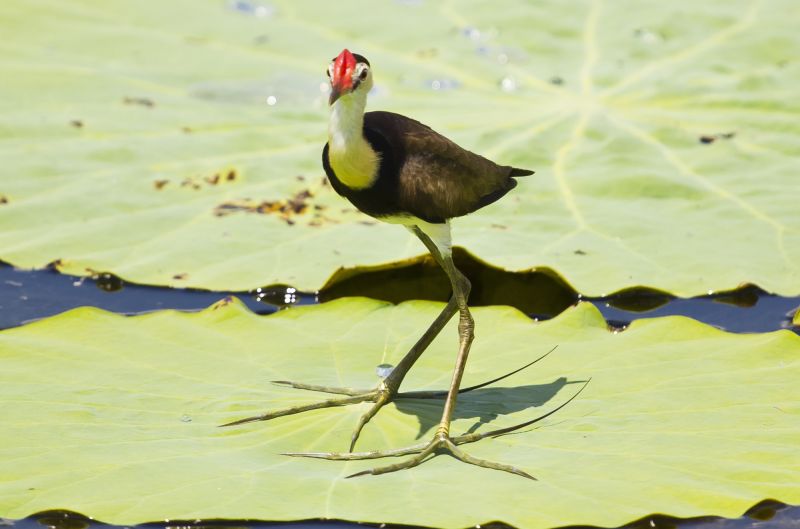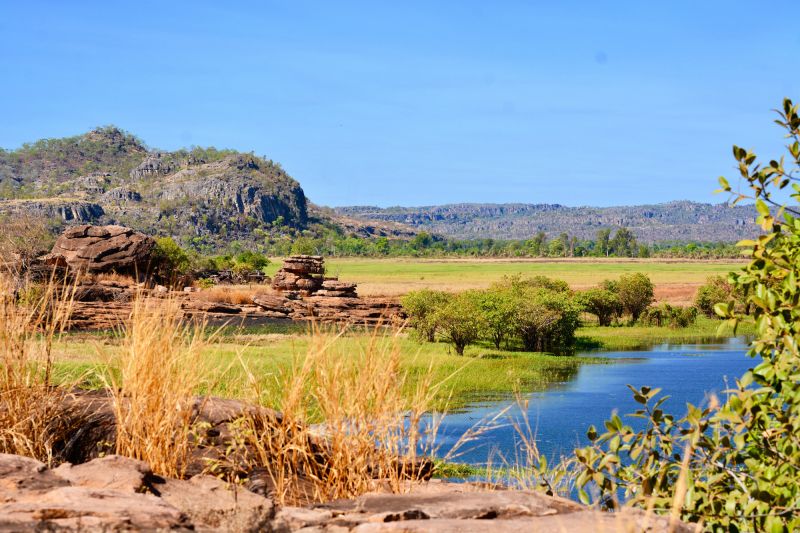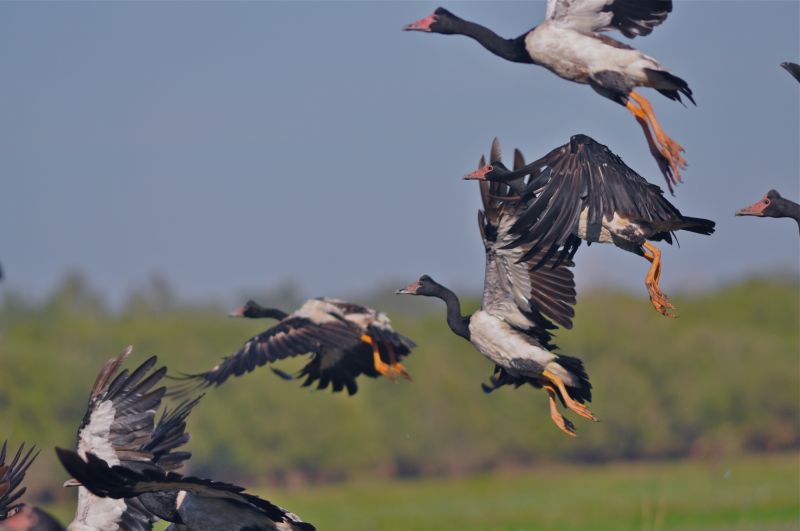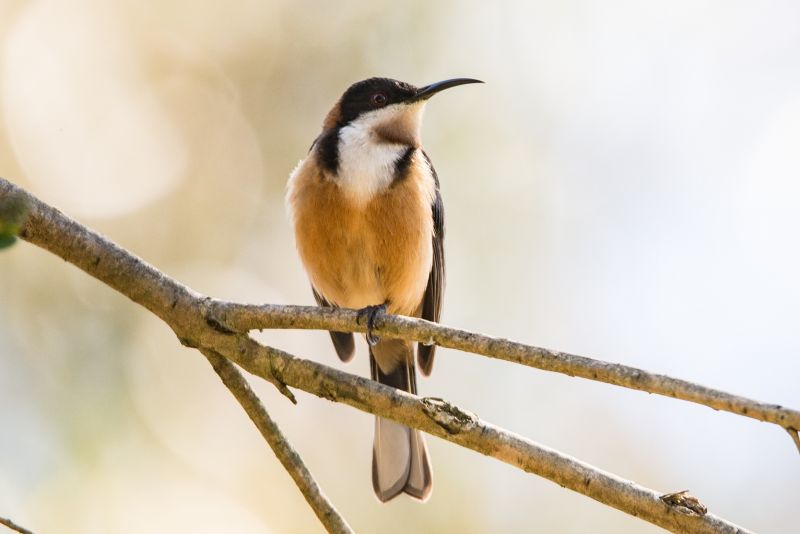Luxury Birdwatching Package
Duration: 14 days/13 nights with Australia-Naturally Travel
Regions: Sydney, Kakadu & Arnhem Land, Kangaroo Island, Flinders Ranges
Price: From £640 per day*
To book today, please contact:
email: info@australianaturallytravel.com.au
Explore some of Australia’s most famous and inspirational landscapes, combining premium lodgings and hospitality, private guiding and exceptionally diverse birding experiences. Highlights include a private pelagic and whale cruise off Sydney Harbour, exploration of Kakadu National Park and Arnhem Land, one of the world’s most magnificent natural reserves, a three day tour of world renowned Kangaroo Island in search of the Glossy-black Cockatoo and a stay at Arkaba, one of the most picturesque outback stations in Australia.
Day 1: Sydney
On arrival into Sydney airport, you will enjoy a private transfer to your hotel (pre-register room for immediate occupancy). The remainder of the day is at leisure with the opportunity to walk around one of the world's most beautiful cities.
Accommodation: Grace Hotel - Deluxe Room
Day 2: Sydney Private Cruise for Pelagics and Whales in Season
After a magical cruise through the famous sights of Sydney, guests will venture out out on a luxury Riviera cruiser to the South Pacific Ocean until the edge of the continental shelf is reached. The passionate onboard guide and photographer will tell you about the migratory routes and behaviour of the various species. Combined with Sydney’s stunning coastal backdrop, this cruise is a truly unforgettable experience. Other marine species that may be encountered on the four hour journey include Bottlenose Dolphins, Minke whales and Humpback Whales between May and November.
With the rich abundance of pelagic birdlife just off the coast of Sydney, this cruise provides a unique opportunity to see some of the world's most admired gliders. An impressive number of species may be encountered including Black-browed, Campbell, Shy, Yellow-nosed, Gibson’s and Wandering Albatross, Fluttering, Wedge-tailed, Hutton’s and Flesh-footed Shearwaters, Providence, Grey-faced, Cape, Northern Giant and Southern Giant Petrels along with a host of Australasian Gannets, Skua’s and Gulls. The grace and majesty of these birds will keep you amazed as they soar, swoop and swim around the boat. On the return to Sydney Harbour, a keen eye will spot various inshore birds, with the occasional sighting of Little Penguins.
Accommodation: Grace Hotel - Deluxe Room

Day 3: Sydney to Darwin
Guests will take a private transfer to Sydney Airport to board flight to Darwin. The remainder of the day is at leisure.
Accomm: Darwin Central Hotel - King Premier
Day 4: Kakadu
After pickup at 7am from your Darwin accommodation, this adventure commences with a drive south on the Stuart Highway, then the Arnhem Highway that leads to the World Heritage Listed Kakadu National Park.
Our first stop en route is Fogg Dam Reserve. Fogg Dam has year-round water coverage which assures its position as an important feeding and roosting site for a wide variety of waterbirds & savanna wood-land birds. Here we shall spend the morning looking for different species & enjoy a couple of the small interpretative walks around the Dam. The large expanses provide fantastic opportunities for panoramic photos and capturing Forest and Azure Kingfishers, Magpie Geese, spoonbills, egrets, ibis, herons, Whistling, Black & Brahminy Kites and cormorants.
Our next stop is the incredibly scenic Leaning Tree Lagoon. This Billabong is often covered in water lilies making it a popular stop for photographers & birdwatchers. This is an ideal opportunity to capture the iconic Comb-crested Jacana before enjoying a delicious lunch. We will leave the main road to enter into Kakadu via the Old Darwin Road. On the back road there are a couple of small billabongs. Our last stop for today is at Cooinda. Here we will experience one of Kakadu’s icons, the Yellow Water Cruise.
This 10sq. km pristine environment supports a truly wonderful variety of plants, birds, crocodiles and Top End wildlife. The wildlife on this pristine billabong is too numerous to mention; you will likely encounter Saltwater Crocodiles, the magnificent White-bellied Sea Eagle and many of the other 280 species that call this billabong home. Here we will witness at close hand the wealth of wildlife in this tranquil habitat and enjoy one of the Top Ends great sunsets via a private cruise.
Likely sightings include Magpie Goose, Plumed Whistling-Duck, Radjah Shelduck, Green Pygmy-Goose, Grey Teal, cormorants, Black-necked Storks, Bitterns, herons, egrets, Glossy Ibis, Australian White Ibis, Straw-necked Ibis, Royal Spoonbills, Purple Swamphens, Black-winged Stilts, Australasian Darters, terns, Azure Kingfishers, Forest Kingfishers, White-bellied Sea-Eagle, Black & Whistling Kites.
Overnight: Permanent Private Camp - Glamping (L, D)
Day 5: Kakadu
This morning at Lord's private camp site, there will be the chance to catch the early morning birds of the savanna woodland. Likely encounters include Sulphur-crested Cockatoos, Little Corellas, Black-Faced Cuckoo-shrikes, White-bellied Cuckoo-shrikes, Peaceful Doves, Shining Flycatchers, various honeyeaters, the Blue-winged Kookaburra and hopefully the Great Bowerbird around it's bower.
After breakfast we shall head down to the south end of the Kakadu National Park. The ridges found in the south of Kakadu National Park were formed over 2500 million years ago as a result of volcanic activity. These picturesque ridges divide the woodland areas, with the regions pristine waterfalls and plunge pools a favourite for park visitors. This is the area to be on the lookout for the rare Hooded Parrot and Gouldian Finch.
A one kilometre walk through sub-monsoon rainforest leads to the base of a beautiful plunge pool: Maguk is a scenic and tranquil place to enjoy a refreshing swim in the series of small waterholes that boast crystal clear waters. The group will enjoy a visit to the magnificent Maguk Falls, looking for the Rainbow Pitta, Black-breasted Buzzard & numerous other species. There are also many unique plants in the area including the beautifully coloured Salmon Gum, Freshwater Mangrove, Silver-leafed Paperback and Yellow Bladderwort orchid.
Overnight: Permanent Private Camp - Glamping (L, D)

Day 6: Arnhem Land
Today we visit Aboriginal Lands (Arnhem Land) access to this area is restricted to a select group of tour operators. Departing the Northern region of Kakadu National Park, we cross Cahill’s Crossing on the East Alligator River and enter Arnhem Land. A 15 kilometre (10 mile) scenic drive to Gunbalanya Aboriginal community provides some of the best driving views in the Top End with floodplains, billabongs & the Arnhem Land escarpment.
This is an ideal environment to encounter the beautifully coloured Rainbow-bee Eaters, Long-tailed Finches, Whistling Kites, various kingfishers along with many waterbirds including Yellow-billed Spoonbills, egrets, ibis, herons and Magpie Geese.
Upon arrival at Gunbalanya the gorup will visit the Injalak Arts and Craft Centre. Here you have the opportunity to meet and watch traditional local artists in action. Established in 1989, Injalak Arts is an Aboriginal organisation supporting the production of quality Aboriginal art. Today, Injalak artists produce authentic art inspired by ancient dreamtime stories, images from the nearby rock art galleries and an unbroken link between the present generation of Kunwinjku people and their ancestors.
This offers an intimate setting to get to know the artist and see first-hand how artworks are created. Gunbalanya is the Aboriginal name for the Oenpelli settlement (which was originally a mission). The area includes the flood plains of the East Alligator River that are covered by water from December to April and a rocky sandstone plateau rising up to 200 metres above the plains.
The stone country of the Arnhem Land plateau was laid down 1650 million years ago and today provide habitat for species such as the Chestnut-quilled Rock Pigeon, Brolga, numerous species of duck, heron, wood-land birds, Black & Brown Falcons, Sandstone Thrush, Channel-billed Cuckoos and Pheasant Coucals.
Return to Darwin. (B, L)
Day 7: Darwin to Adelaide
Guests will take a private transfer to Darwin Airport to board flight to Adelaide. The remainder of the day is at leisure
Day 8: Kangaroo Island
An early transfer to Adelaide airport will proceed a short 25 minute fligtht to Kingscote Airport. Kangaroo Island is a birdwatcher's paradise, with the opportunity to spot over 260 birds, almost one-third of Australia's bird count. Over 90% of the Island is mallee and woodland, with beautiful Eucalyptus groves, shrublands, fernlands and forests. The island is blessed with amazing protected coves and beaches through to rugged cliffs, providing abudant opportunities to spot seabirds, waterbirds and waders.
Upon flying into Kangaroo Island, guests will be greeted by an Island guide. The first stop is Duck Lagoon – a freshwater billabong where typical encounters include: White-eared, White-naped and Brown-headed Honeyeaters; Crimson Rosellas; Superb Fairy-wrens; Black Swans; Grey and Chestnut Teals; Yellow-billed Spoonbills; Pacific Black Ducks; Australasian and Hoary-headed Grebes; Chestnut-breasted Shelducks; Little Pied Cormorants; and (seasonally) Freckled Ducks. After enjoying a delicious morning tea, guests will venture to Roper’s Gums – a tall Eucalyptus forest where guests will learn about the the endemic Glossy Black Cockatoo recovery plan.
After viewing the beautiful headwaters of Cygnet River, guests will arrive at a private lunch site and a seafood barbeque lunch. This area is home to Koalas; Crescent & New Holland Honeyeaters; Eastern Spinebills; Grey Fantails; Rainbow and Purple-crowned Lorikeets; Yellow-tailed Black Cockatoos and a selection of smaller bush birds. After lunch, travellers will explore Lathami Conservation Park, which protects the habitat of the Glossy Black Cockatoo. In this area, it is common to encounter Kangaroo Island Kangaroos; Tammar Wallabies; Scarlet Robins; Brown Thornbills; Grey Shrike Thrush; Short-beaked Echidnas; Golden Whistlers; and Beautiful Firetails. Ending the day at the gorgeous Stokes Bay, guests will enjoy the opportunity to spot Australian Pelicans; Eastern Reef Herons, Hooded Plovers and White-bellied Sea-eagles, before arriving to American River.
Mercure Kangaroo Island Lodge (dinner/bed/breakfast)

Day 9: Kangaroo Island
Guests will have the option of an early morning birding excursion in the bush adjacent to the hotel or along the American River shoreline. Glossy Black Cockatoos are frequent encounters, as are Grey Currawongs, Little Corellas, Galahs and Black-faced Cuckoo-shrikes. Along the shorelines, there are often Pied Oystercatchers, Royal Spoonbills, Black Swans, Grey Teals, Australian White Ibis and Australian Pelicans. Rufous Night Herons often roost in the large pines opposite the fire station. Guests will arrive back to the hotel for breakfast before departing at 8:30am.
During the drive to Seal Bay, the first main destination for the day, guests should look out for Raptors. Possibilities include Wedge-tailed Eagles, Swamp Harriers, Australian Kestrels, Black-shouldered Kites and Brown Falcons. At Seal Bay, guests will enjoy a private guided Australian sea-lion experience. The sea-lions share the beach with Caspian and Crested Tern, Sooty Oystercatchers and Hooded Plovers. Overhead, it is common to see White-bellied Sea Eagles and Ospreys. The headland to the west is a prime habitat for Great and Pied Cormorants.
Next is Point Ellen where seasonal encounters include Rock Parrots, Fairy Terns and Little Penguins can sometimes be found in burrows near the beacon. During morning tea, guests will keep an ear out for Southern Emu-wrens, Purple-gaped Honeyeaters and Western Whipbirds in the heath and mallee. The massive wilderness expanses of Flinders Chase National Park is the focus for the rest of the day, starting with the Rocky River precinct. Encounters here can include Cape Barren Geese, Crescent Honeyeaters, Little and Red Wattlebirds, Striated and Spotted Pardalotes, Australian Ravens, Koalas, Kangaroo Island Kangaroos, Short-beaked Echidnas, Rosenberg’s Goanna (seasonal) and Tammar Wallabies.
Next is the iconic Remarkable Rocks, a spectacular natural sculpture on the clifftops. Here the group can have a picnic lunch – looking out for Australian Kestrels, Tawny-crowned Honeyeaters, and another chance to try for Southern Emu-wren and the elusive Western Whipbird. Nearby on the cape is Admiral’s Arch – a sea cave which often turns up Australian Ravens, Sooty Oystercatchers, Crested Terns (which have had Antarctic terns amongst them in 2006 and 2007), Pacific Gulls.
If a south-westerly wind is blowing, there is a chance to see some pelagic species. If time permits, guests will have the option to visit “Grassdale” in Kelly Hill Conservation Park, providing abundant opportunities to see kangaroos in the wild, plus a range of bird habitats.
Mercure Kangaroo Island Lodge (dinner/bed/breakfast)

Day 10: Kangaroo Island
There is an option to take another early morning birding walk as per the previous day, with a 8:15am departure from American River. This morning, guests will go out on the ocean on a boat to get a close look at the Busby Islet. The group will observe numerous birds from the sea, as this is a prohibited area to protect breeding Australian Pelicans, Royal Spoonbills, Black-faced and Pied cormorants, Australian White Ibis and potentially many other species including international migratory species seasonally (Nov – Mar). White-bellied Sea Eagles constantly harass the nesting birds, providing an excellent chance to see Black Swans and chance encounters with Bottle-nosed Dolphins.
Guests will have lunch at Reeves Point, providing a chance to learn about the settlement history of the island and often turns up quite a few birds – depending on the season. After lunch, a visit the Kingscote Oxidation Pond provides the opportunity to spot a good cross-section of waterfowl on the ponds and the adjacent Cygnet River Estuary is always worth a look. The afternoon includes a visit to D’Estrees Bay (Hooded Plovers, Ruddy Turnstones (seasonally), Ospreys, Rock Parrots (seasonally) and a quick look at one of the MacGillivray Wetlands on the way back to the airport if time permits. Guests will take a flight to Adelaide.
Accommodation – Majestic Roof Garden Hotel - Suite
Day 11: Arkaba, Flinders Ranges
Guests will take a private transfer to Arkaba via beautiful rural scenery (optional charter flight at extra cost if desired).
Arkaba’s beautifully restored 1850s homestead, welcoming just ten guests at a time, is surrounded by 60,000 acres of privately-owned and carefully protected outback. Nestled within South Australia’s Ikara-Flinders Ranges, a five-hour drive or 1 hour flight from Adelaide, the unusual blend of semi-arid and temperate habitats supports 1,200 plant species and nearly 300 species of birds. Against the dramatic backdrop of the Elder Range and Wilpena Pound, ancient sea beds and salt lakes have given way to spectacular rock formations, cypress pines and river red gums; this is an incredibly old landscape supporting a varied population of spectacular birds.
Upon arrival, your afternoon safari will have you heading out on a short walk following the Arkaba Creek through River Red Gum habitat where recovering understory supports healthy populations of galahs, honeyeater species, parrots and Emus. Arkaba’s new viewing hide has been carefully carved out close to the confluence of Arkaba and Woolshed creeks and provides an ideal vantage point for all kinds of wildlife coming to drink. Not only a place to see, but to watch all the fascinating interactions that occur between species.
Rare and special highlights here include the Apostlebirds, Yellow-throated Miner and the stunning Elegant Parrot. Enjoy a hosted three-course dinner with matching South Australian wine on the terrace overlooking the ranges and overnight at Arkaba Homestead.
Each room has a character of its own and has been named after early settlers, explorers or property owners. The décor has been hand-fashioned by wildlife artist, Rosie Woodford-Ganf. Bedheads are made from recycled fence posts and fleeces, curtains tied back by gumnut tassels, lights are perched on explorers' tripod theodolites.
A comfortable library provides some seclusion for enjoying a quiet drink and a good book, while dinner is often hosted on the terrace overlooking the ranges. A self-service bar with a comprehensive selection of beverages is available and the resident chef loves serving you thoughtful bush inspired cuisine after your days out admiring the incredible birds of this place. Arkaba’s wine list is entirely South Australian and wines will be matched with each of your evening meals.
Accommodation – Arkaba Homestead
Arkaba | Australian Natives at The Hide from Wild Bush Luxury on Vimeo.
Day 12: Arkaba, Flinders Ranges
On safari today we’ll explore a variety of habitats. Recovering riparian vegetation throughout the numerous creek-beds that carve their way through the Arkaba Conservancy provide a wonderful leafy canopy which is alive with a multitude of parrots, corellas, pardalotes, honeyeaters and the ever melodious Grey Shrike- thrush.
Open spinifex grasslands allow for a totally different birding experience - grasswrens, pipits and Hovering Black-shouldered Kites are often sighted here. Huge areas of pioneer Acacia species provide both food and habitat for incredible numbers of thornbills , babblers, Red-Capped Robins and little explosions of colour in the busy fairy-wren species too. Although the Chestnut- crowned Babbler is seldom seen, this boisterous co-operative breeder has a distinctive alarm call.
Standout encounters today are endless and include Rufous Whistler, Grey-fronted Honeyeater, Spotted Harrier, Red-backed Kingfisher and the Inland Thornbill amongst many others. Your afternoon is capped off with sundowner drinks on top of the ranges with the scale and grandeur of outback Australia laid out for miles around. Dinner is hosted by one of Arkaba’s field guides providing an atmosphere more akin to staying with friends in the country, or a private safari lodge rather than a typical luxury hotel.
Accommodation – Arkaba Homestead
Day 13: Arkaba, Flinders Ranges
Early safari drive to Stokes Hill on the lookout for the elusive and endemic Short- tailed Grasswren and not forgetting smaller colourful species such as the White- winged Fairy-wrens before we venture into the spectacular Brachina Gorge in the Ikara-Flinders Ranges National Park.
Home to fossils of the unique Ediacaran fauna and once used as a pass through which bullock teams pulled their loads, the scree slope on the western side of the gorge provides the perfect opportunity to see the beautifully decorated near-threatened Yellow-footed Rock-wallaby endemic to the region.
We will look for rocky desert species such as Australian Pipits and Yellow Chats and the Wood Duck Dam on return is home to Grebe and other water species. Exceptional opportunities include Black-fronted Dotterel, Short-tailed Grasswren, Orange and Crimson Chat.
Guests will then take a private transfer from Arkaba to Adelaide via the scenic route including a visit to the world famous Clare Valley wine region.
Accommodation – Majestic Roof Garden Hotel - Suite
Day 14:
Depart Hotel to transfer to Adelaide airport for departure flight.
![]()
To book today, please contact:
email: info@australianaturallytravel.com.au
*Rates are per person, twin share based on 2 people travelling. Costs valid to 31 March 2019 – and subject to availability at time of booking and currency fluctuations. Tour can operate between April and mid-October – subject to availability. All tours and transfers are private. No airfares included, except ADL/KGC & KGC/ADL
